Polyrhachis bihamata
| Polyrhachis bihamata | |
|---|---|

| |
| Scientific classification | |
| Kingdom: | Animalia |
| Phylum: | Arthropoda |
| Class: | Insecta |
| Order: | Hymenoptera |
| Family: | Formicidae |
| Subfamily: | Formicinae |
| Tribe: | Camponotini |
| Genus: | Polyrhachis |
| Subgenus: | Polyrhachis |
| Species group: | bihamata |
| Species: | P. bihamata |
| Binomial name | |
| Polyrhachis bihamata (Drury, 1773) | |
| Synonyms | |
| |
Specimens have been collected from rainforest. Hung (1970) - In East India, one bihamata nest of silky yellowish-brown material was found close to the ground in the center of a dump of bamboos (Bingham, 1903).
Identification
A member of the bihamata group of the subgenus Polyrhachis.
Zettel (2019) - Size usually large, dimensions (according to Kohout 2014): body length ca. 9.5–12.0 mm, head width 1.91–2.47 mm. Bicoloured: head, antenna, tips of spines, and legs black; mesosoma, petiole and most of gaster orange brown (apex of gaster variably infuscated). Short pubescence very dense, sparse on head and gaster. Standing setae long and abundant all over trunk, short but numerous on scape. Surface matt. Eyes in full-face view just not reaching outline of head. Ocelli usually present. Pronotal spines pointing posteriorly. Dorsum of propodeum laterally rounded, posteriorly with a pair of short transverse carinae; spiracles not strongly elevated. Petiole columnar; petiolar spines hooked, parallel for most of length. Gaster tergites 1–3 with fine, dense puncturation or reticulation.
Polyrhachis bihamata can be readily identified with the key by Kohout (2014), when considering Polyrhachis dostali, Polyrhachis lacroixi and Polyrhachis tonsilis. These three species are easily separable from P. bihamata by their strongly reduced standing pilosity. However, I have seen a few specimens of P. bihamata with a vestigial median ocellus, which do not fully fit the character “median ocellus always present” in couplet 9.
Keys including this Species
- Key to Polyrhachis (Polyrhachis) species
- Key to Polyrhachis of India
- Key to Polyrhachis s.str. of Malay Peninsula
Distribution
Kohout (2014) - Polyrhachis bihamata has been recorded throughout Southeast Asia, from Vietnam, Laos, Thailand and Myanmar to Malaysia and south to Borneo, Sumatra, possibly Java and Bali. It was also listed by Fr. Smith (1858: 58; 1862: 39; 1863: 126; 1865: 69) variously from India, the Indonesian islands of Waigeo, Bacan, Seram and Sulawesi and from New Guinea, however, I believe that many of these records are based on misidentified specimens, representing mostly Polyrhachis olybria and/or Polyrhachis bellicosa and Polyrhachis erosispina.
Latitudinal Distribution Pattern
Latitudinal Range: 21.91997222° to -2.76051899°.
| North Temperate |
North Subtropical |
Tropical | South Subtropical |
South Temperate |
- Source: AntMaps
Distribution based on Regional Taxon Lists
Indo-Australian Region: Borneo, Brunei Darussalam, Indonesia, Malaysia, Philippines.
Oriental Region: Cambodia, India, Laos, Myanmar, Thailand, Vietnam.
Palaearctic Region: China.
Distribution based on AntMaps
Distribution based on AntWeb specimens
Check data from AntWeb
Countries Occupied
| Number of countries occupied by this species based on AntWiki Regional Taxon Lists. In general, fewer countries occupied indicates a narrower range, while more countries indicates a more widespread species. |

|
Estimated Abundance
| Relative abundance based on number of AntMaps records per species (this species within the purple bar). Fewer records (to the left) indicates a less abundant/encountered species while more records (to the right) indicates more abundant/encountered species. |

|
Biology
Association with Other Organisms
 Explore: Show all Associate data or Search these data. See also a list of all data tables or learn how data is managed.
Explore: Show all Associate data or Search these data. See also a list of all data tables or learn how data is managed.
- This species is a host for the fungus Ophiocordyceps irangiensis (a parasitoid) (Quevillon, 2018) (encounter mode primary; direct transmission; transmission outside nest).
- This species is a host for the fungus Ophiocordyceps myrmecophila (a parasitoid) (Quevillon, 2018) (encounter mode primary; direct transmission; transmission outside nest).
Castes
Male and immature stages in SMFG (Dr W.H.O. Dorow coll.); a single male in QMBA.
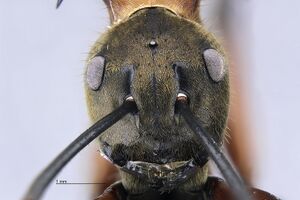   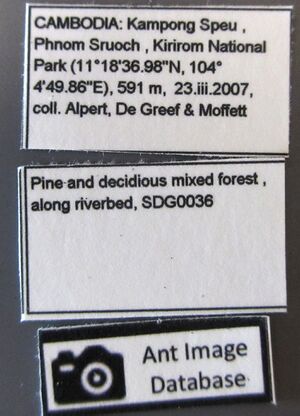   
| |
| . | Owned by Museum of Comparative Zoology. |
  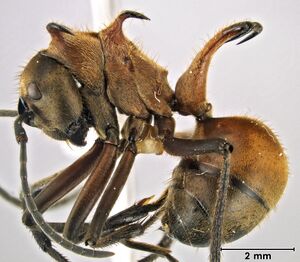  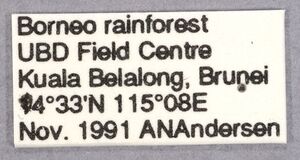 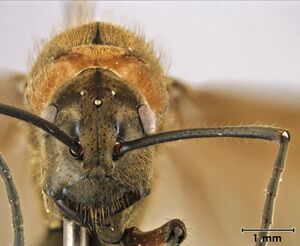       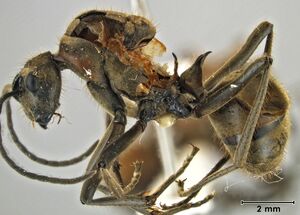  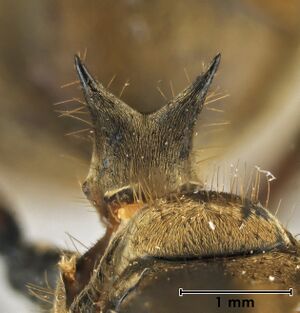 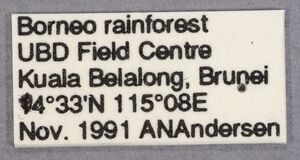
| |
| . | |
Images from AntWeb

| |
| Worker. Specimen code casent0010659. Photographer April Nobile, uploaded by California Academy of Sciences. | Owned by CAS, San Francisco, CA, USA. |
Nomenclature
The following information is derived from Barry Bolton's Online Catalogue of the Ants of the World.
- bihamata. Formica bihamata Drury, 1773: 73, pl. 38, figs. 7, 8 (w.) MADAGASCAR (Johanna I.). [Locality in error, see Bolton, 1973b: 352.] Mayr, 1872: 139 (q.); Emery, 1887a: 238 (q.); Donisthorpe, 1942b: 70 (m.); Wheeler, G.C. & Wheeler, J. 1990b: 763 (l.). Combination in Polyrhachis: Smith, F. 1857a: 59. Senior synonym of affinis Le Guillou: Mayr, 1872: 139; Dalla Torre, 1893: 259; of minor Karavaiev, perplexa, tonsilis: Hung, 1970: 16; Kohout, 1998: 508.
- affinis. Formica affinis Le Guillou, 1842: 314 (q.) BORNEO. [Unresolved junior primary homonym of Formica affinis Leach, 1825: 290.] Combination in Polyrhachis: Roger, 1863b: 7. Junior synonym of bihamata: Mayr, 1872: 139; Dalla Torre, 1893: 259.
- perplexa. Polyrhachis (Polyrhachis) bihamata var. perplexa Santschi, 1925f: 92 (w.) LAOS. Junior synonym of bihamata: Hung, 1970: 16.
- minor. Polyrhachis bihamata var. minor Karavaiev, 1927e: 12 (w.) INDONESIA (Java). [Unresolved junior primary homonym of minor Forel, above.] Junior synonym of bihamata: Hung, 1970: 16.
Type Material
Neotype worker (designation by Zettel, 2019: 68): Thailand, Chiang Mai Province, Doi Suthep-Pui National Park, Chiang Mai, environment of Monthatarn Falls, N 18°48', E 98°56', 700–750 m a.s.l., 6.XI.1995, leg. H. Zettel (#8), in the Natural History Museum Vienna.
Description
Worker
Hung (1970) - Syntypes: Four workers of perplexa measured-HW 2.30-2.45 mm, HL 2.63-2.75 mm, CI 87-89, SL 3.35-3.58 mm, SI 138-146, PW 1.25-1.37 mm, MPL 4.50-4.88 mm, PSEI 67-71. PH 3.00-3.18 mm. Two workers of tonsilis measured HW 2.15-2.25 mm, HL 2.50 mm, CI 86.90, SL 3.13-3.15 mm, SI 139-146, PW 1.05-1.13 mm, MPL 2.50 mm, MTL (missing), PSEI 67-68, PH 2.75-2.90 mm.
HW 1.88-2.50 mm, HL 2.25-2.75 mm, CI 75-97, SL 3.00-3.50 mm, SI 133-170, PW 1.05-1.40 mm, MPL 2.38-3.15 mm, MTL 4.00-4.75 mm, PSEI 64-115. PH 2.50-3.13 mm. Alitrunk more or less rounded. Pronotum somewhat flat above but without traces of margins. Pronotal spines pointed outwards and bent backwards. Mesonotum with two pyramidal spines contiguous at base, rising upwards and bent backwards. Metanotal groove replaced by a ridge. Propodeum with two contiguous ridges. Basal face inclined, about twice as long as the declivity. Petiole columnar bearing a pair of long, somewhat flattened hook-shaped spines which in most cases are parallel or even contiguous. Body sparsely covered with suberect hairs. Head black. Alitrunk. petiole, gaster and legs moderate reddish-brown or grayish-red, but the tip of the gaster is always darker in color.
Kohout (2014) - TL c. 9.47 – 11.99; HL 2.17 – 2.77; HW 1.91 – 2.47; CI 81-94; SL 2.82 – 3.53; SI 133 – 149; PW 1.11 – 1.36; PeH 2.37 – 3.12; PeI 100-119; MTL 3.98 – 4.79 (19 measured).
Dimensions (bihamata perplexa syntypes): TL c. 10.84 – 12.45; HL 2.50 – 2.71; HW 2.25 – 2.37; CI 87 – 90; SL 3.17 – 3.53; SI 140 – 149; PW 1.16 – 1.26; PeH 2.92 – 3.12; PeI 113 – 119; MTL 4.33 – 4.84 (6 measured).
Dimensions (bihamata tonsilis syntypes): TL c. 10.08 – 10.73; HL 2.43 – 2.46; HW 2.15 – 2.21; CI 88 – 90; SL 3.12; SI 141 – 145; PW 1.06; PeH 2.77 – 2.87; PeI 114 – 117; MTL (missing) (2 measured).
Dimensions (bihamata minor holotype): TL c. 9.12; HL 2.21; HW 1.96; CI 89; SL (missing); PW 1.06; PeH 2.25; PeI 102; MTL 3.93.
Queen
Kohout (2014) - TL c. 13.30; HL 2.77; HW 2.37; CI 85; SL 3.93; SI 166; PW 2.67; PeH 1.31; PeI 47; MTL 4.69 (1 measured).
Queen distinctly larger than worker and with usual characters identifying full sexuality, including three ocelli, complete thoracic structure and wings. The queen of P. bihamata was described by Mayr (1872) and the details are not repeated here. It is somewhat similar to queen of P. ypsilon, with both having the pronotal spines reduced to bluntly angular prominences. The mesoscutum in P. bihamata, however, is distinctly more slender and the golden pilosity and pubescence shorter and less abundant.
References
- Donisthorpe, H. 1942b. Descriptions of a few ants from the Philippine Islands, and a male of Polyrhachis bihamata Drury from India. Ann. Mag. Nat. Hist. 11(9): 64-72. (page 70, male described)
- Baltazar, C.R. 1966. A catalogue of Philippine Hymenoptera (with a bibliography, 1758-1963). Pacific Insects Monographs 8: 1-488. (page 279, listed)
- Bolton, B. 1973b. The ant genus Polyrhachis F. Smith in the Ethiopian region (Hymenoptera: Formicidae). Bull. Br. Mus. (Nat. Hist.) Entomol. 28: 283-369 (page 352, [Locality in error, see Bolton, 1973b: 352.])
- Cantone S. 2017. Winged Ants, The Male, Dichotomous key to genera of winged male ants in the World, Behavioral ecology of mating flight (self-published).
- Dalla Torre, K. W. von. 1893. Catalogus Hymenopterorum hucusque descriptorum systematicus et synonymicus. Vol. 7. Formicidae (Heterogyna). Leipzig: W. Engelmann, 289 pp. (page 259, Senior synonym of affinis)
- Drury, D. 1773. Illustrations of natural history. Wherein are exhibited upwards of two hundred and twenty figures of exotic insects, according to their different genera. Vol. 2. London: B. White, vii + 90 pp. (page 73, pl. 38, figs. 7, 8 worker described)
- Emery, C. 1887a [1886]. Catalogo delle formiche esistenti nelle collezioni del Museo Civico di Genova. Parte terza. Formiche della regione Indo-Malese e dell'Australia. [part]. Ann. Mus. Civ. Stor. Nat. 24[=(2)(4): 209-240 (page 238, queen described)
- Hung, A. C. F. 1970. A revision of ants of the subgenus Polyrhachis Fr. Smith (Hymenoptera: Formicidae: Formicinae). Orient. Insects 4: 1-36 (page 16, Senior synonym of minor Karavaiev, perplexa and tonnsilis)
- Khachonpisitsak, S., Yamane, S., Sriwichai, P., Jaitrong, W. 2020. An updated checklist of the ants of Thailand (Hymenoptera, Formicidae). ZooKeys 998, 1–182 (doi:10.3897/zookeys.998.54902).
- Kohout, R. J. 1998. New synonyms and nomenclatural changes in the ant genus Polyrhachis Fr. Smith (Hymenoptera: Formicidae: Formicinae). Mem. Qld. Mus. 42: 505-531 (page 508, Senior synonym of minor Karavaiev, perplexa and tonnsilis)
- Kohout, R.J. 2014. A review of the subgenus Polyrhachis (Polyrhachis) Fr. Smith (Hymenoptera: Formicidae: Formicinae) with keys and description of a new species. Asian Myrmecology 6, 1–31.
- Liu, C., Fischer, G., Hita Garcia, F., Yamane, S., Liu, Q., Peng, Y.Q., Economo, E.P., Guénard, B., Pierce, N.E. 2020. Ants of the Hengduan Mountains: a new altitudinal survey and updated checklist for Yunnan Province highlight an understudied insect biodiversity hotspot. ZooKeys 978, 1–171 (doi:10.3897/zookeys.978.55767).
- Mayr, G. 1872. Formicidae Borneenses collectae a J. Doria et O. Beccari in territorio Sarawak annis 1865-1867. Ann. Mus. Civ. Stor. Nat. 2: 133-155 (page 139, Senior synonym of affinis Le Guillou)
- Narendra, A., Ramirez-Esquivel, F., Ribi, W.A. 2016. Compound eye and ocellar structure for walking and flying modes of locomotion in the Australian ant, Camponotus consobrinus. Scientific Reports 6, 22331 (doi:10.1038/srep22331).
- Radchenko, A.G., Fisher, B.L., Esteves, F.A., Martynova, E.V., Bazhenova, T.N., Lasarenko, S.N. 2023. Ant type specimens (Hymenoptera, Formicidae) in the collection of Volodymyr Opanasovych Karawajew. Communication 1. Dorylinae, Poneromorpha and Pseudomyrmecinae. Zootaxa, 5244(1), 1–32 (doi:10.11646/zootaxa.5244.1.1).
- Smith, F. 1857a. Catalogue of the hymenopterous insects collected at Sarawak, Borneo; Mount Ophir, Malacca; and at Singapore, by A. R. Wallace. [part]. J. Proc. Linn. Soc. Lond. Zool. 2: 42-88 (page 59, Combination in Polyrhachis)
- Smith, Fr. 1863. Notes on the geographical distribution of the aculeate Hymenoptera collected by Mr. A.R. Wallace in the Eastern Archipelago. Journal of the Proceedings of the Linnean Society of London, Zoology 7: 109-131.
- Wheeler, G. C.; Wheeler, J. 1990b. Larvae of the formicine ant genus Polyrhachis. Trans. Am. Entomol. Soc. 116: 753-767 (page 763, larva described)
- Wong, T.L., Guénard, B. 2020. Review of ants from the genus Polyrhachis Smith (Hymenoptera: Formicidae: Formicinae) in Hong Kong and Macau, with notes on their natural history. Asian Myrmecology 13: e013001 (doi:10.20362/am.013001).
- Yamane, S., Tanaka, H.O., Hasimoto, Y., Ohashi, M., Meleng, P., Itioka, T. 2021. A list of ants from Lambir Hills National Park and its vicinity, with their biological information: Part II. Subfamilies Leptanillinae, Proceratiinae, Amblyoponinae, Ponerinae, Dorylinae, Dolichoderinae, Ectatomminae and Formicinae. Contributions from the Biological Laboratory, Kyoto University 31, 87–157.
- Zettel, H. 2019. Two new species from Malaysia and further taxonomic notes on Polyrhachis s.str. (Hymenoptera: Formicidae). Zeitschrift der Arbeitsgemeinschaft Österreichischer Entomologen 71: 57-73.
References based on Global Ant Biodiversity Informatics
- André E. 1892. Voyage de M. Chaper à Bornéo. Catalogue des fourmis et description des espèces nouvelles. Mém. Soc. Zool. Fr. 5: 46-55.
- Ashmead W. H. 1904. A list of the Hymenoptera of the Philippine Islands, with descriptions of new species. J. N. Y. Entomol. Soc. 12:1-22.
- Chapman J. W. 1965. Studies on the ecology of the army ants of the Philippines genus Aenictus Schuckard (Hymenoptera: Formicidae). Philippine Journal of Science. 93: 551-595.
- Chapman, J. W., and Capco, S. R. 1951. Check list of the ants (Hymenoptera: Formicidae) of Asia. Monogr. Inst. Sci. Technol. Manila 1: 1-327
- Chung A.Y.C., and M. Mohamed. 1996. A comparative study of the ant fauna in a primary and secondary forest in Sabah, Malaysia. In Edwards, D.S. Booth, W.E. and S.C. Choy (eds). Tropical Rainforest Research. Kluwer Academic Publishers. Pp 357-366.
- Crawley W.C. 1924. Ants from Sumatra, with biological notes by Edward Jacobson. Annals and Magazine of Natural History (9)13: 380-409
- Davidson D. W., S. C. Cook, R. R. Snelling and T. H. Chua. 2003. Explaining the Abundance of Ants in Lowland Tropical Rainforest Canopies. Science 300: 969-972.
- Davidson, D.W., J.-P. Lessard, C.R. Bernau and S.C. Cook. 2007. The Tropical Ant Mosaic in a Primary Bornean Rain Forest. Biotropica 39(4):468-475
- Donisthorpe H. 1942. Descriptions of a few ants from the Philippine Islands, and a male of Polyrhachis bihamata Drury from India. Annals and Magazine of Natural History (11)9: 64-72.
- Donisthorpe, Horace. 1943. The Ants of Waigeu Island, North Dutch New Guinea. The Annals and Magazine of Natural History 11 (10): 433-475.
- Emery C. 1887. Catalogo delle formiche esistenti nelle collezioni del Museo Civico di Genova. Parte terza. Formiche della regione Indo-Malese e dell'Australia. [part]. Ann. Mus. Civ. Stor. Nat. 24(4): 209-258.
- Emery C. 1888. Catalogo delle formiche esistenti nelle collezioni del Museo Civico di Genova. Parte terza . Formiche raccolte dal sig. Elio Modigliani in Sumatra e nell'isola Nias. Annali del Museo Civico di Storia Naturale 25: 528-534.
- Emery C. 1893. Formicides de l'Archipel Malais. Revue Suisse de Zoologie 1: 187-229.
- Emery C. 1893. Voyage de M. E. Simon aux îles Philippines (mars et avril 1890). Formicides. Annales de la Société Entomologique de France 62: 259-270.
- Emery C. Formiche raccolte da Elio Modigliani in Sumatra, Engano e Mentawei. Annali del Museo Civico di Storia Naturale 40: 661-722.
- Emery, C. "Catalogo delle formiche esistenti nelle collezioni del Museo Civico di Genova. Parte terza. Formiche della regione Indo-Malese e dell'Australia." Annali del Museo Civico di Storia Naturale Giacomo Doria (Genova) (2) 4, no. 24 (1887): 209-258.
- Emery, C. "Formiche raccolte da Elio Modigliani in Sumatra, Engano e Mentawei." Annali del Museo Civico di Storia Naturale Giacomo Doria (Genova) (2) 20, no. 40 (1900): 661-722.
- Emery, C. "Voyage de MM. Bedot et Pictet dans l'Archipel Malais. Formicides de l'Archipel Malais." Revue Suisse de Zoologie 1 (1893): 187-229.
- Forel A. 1886. Études myrmécologiques en 1886. Annales de la Société Entomologique de Belgique. 30: 131-215.
- Forel A. 1893. Les Formicides de l'Empire des Indes et de Ceylan. Part III. J. Bombay Nat. Hist. Soc. 8: 17-36.
- Forel A. 1903. Les fourmis des îles Andamans et Nicobares. Rapports de cette faune avec ses voisines. Rev. Suisse Zool. 11: 399-411.
- Forel A. 1913k. Wissenschaftliche Ergebnisse einer Forschungsreise nach Ostindien ausgeführt im Auftrage der Kgl. Preuss. Akademie der Wissenschaften zu Berlin von H. v. Buttel-Reepen. II. Ameisen aus Sumatra, Java, Malacca und Ceylon. Gesammelt von Herrn Prof. Dr. v. Buttel-Reepen in den Jahren 1911-1912. Zoologische Jahrbücher. Abteilung für Systematik, Geographie und Biologie der Tiere 36:1-148.
- Guénard B., and R. R. Dunn. 2012. A checklist of the ants of China. Zootaxa 3558: 1-77.
- Hashimoto Y., S. Yamane, and T. Itioka. 1997. A preliminary study on dietary habits of ants in a Bornean rain forest. Japanese Journal of Entomology 65(4): 688-695.
- Hua Li-zhong. 2006. List of Chinese insects Vol. IV. Pages 262-273. Sun Yat-sen university Press, Guangzhou. 539 pages.
- Hung A. C. F. 1970. A revision of ants of the subgenus Polyrhachis Fr. Smith (Hymenoptera: Formicidae: Formicinae). Oriental Insects 4(1): 1-36.
- IZIKO South Africa Museum Collection
- Jaitrong W., B. Guenard, E. P. Economo, N. Buddhakala, and S. Yamane. 2016. A checklist of known ant species of Laos (Hymenoptera: Formicidae). Asian Myrmecology 8: 1-32. DOI: 10.20362/am.008019
- Jaitrong W., and T. Ting-Nga. 2005. Ant fauna of Peninsular Botanical Garden (Khao Chong), Trang Province, Southern Thailand (Hymenoptera: Formicidae). The Thailand Natural History Museum Journal 1(2): 137-147.
- Jaitrong W.; Nabhitabhata, J. 2005. A list of known ant species of Thailand. The Thailand Natural History Museum Journal 1(1): 9-54.
- Kishimoto-Yamata K., F. Hyodo, M. Matsuoka, Y. Hashimoto, M. Kon, T. Ochi, S. Yamane, R. Ishii, and T. Itioka. 2012. Effects of remnant primary forests on ant and dung beetle species diversity in a secondary forest in Sarawak, Malaysia. Journal of Insect Conservation DOI 10.1007/s10841-012-9544-6
- Kohout R. J. 1998. New synonyms and nomenclatural changes in the ant genus Polyrhachis Fr. Smith (Hymenoptera: Formicidae: Formicinae). Memoirs of the Queensland Museum 42: 505-531
- Kohout R. J. 2014. A review of the subgenus Polyrhachis (Polyrhachis) Fr. Smith (Hymenoptera: Formicidae: Formicinae) with keys and description of a new species. Asian Myrmecology 6: 1-31.
- Malsch A. K. F., K. Rosciszewski, and U. Maschwitz. 2003. The ant species richness and diversity of a primary lowland rain forest, the Pasoh Forest reserve, West Malaysia. in T. Okuda, N. Manokaran, Y. Matsumoto, K. Niiyama, S. C. Thomas, and P. S. Ashton, eds. Pasoh: Ecology and Natural History of a Southeast Asin Lowland Tropical Rain Forest, pp 347-374.
- Mohamed M. 1995. A preliminary list of ants (Hymenoptera: Formicidae) of the Tawau Hills Park, Sabah. In: Ghazally Ismail et al. (eds.), Tawau Hills Park, Sabah, Pelanduk Pub. Pp. 205-213.
- Mohanraj P., M. Ali, and K. Veerakumari. 2010. Formicidae of the Andaman and Nicobar Islands (Indian Ocean: Bay of Bengal). Journal of Insect Science 10: Article 172
- Mohanraj, P., M. Ali and K. Veenakumari. 2010. Formicidae of the Andaman and Nicobar Islands (Indian Ocean: Bay Of Bengal). Journal of Insect Science 10:172.
- Pfeiffer M.; Mezger, D.; Hosoishi, S.; Bakhtiar, E. Y.; Kohout, R. J. 2011. The Formicidae of Borneo (Insecta: Hymenoptera): a preliminary species list. Asian Myrmecology 4:9-58
- Philpott S.M., P. Bichier, R.A. Rice, and R. Greenberg. 2008. Biodiversity conservation, yield, and alternative products in coffee agroecosystems in Sumatra, Indonesia. Biodivers. Conserv. 17: 1805-1820. Data obtained from Stacy Philpott
- Ran H., and S. Y. Zhou. 2013. Checklist of Chinese Ants: Formicomorph Subfamilies ( Hymenoptera: Formicidae) (III). Journal of Guangxi Normal University : Natural Science Edition 31(1): 104-111.
- Robson Simon Database Polyrhachis -05 Sept 2014
- Santschi F. 1920. Fourmis d'Indo-Chine. Annales de la Société Entomologique de Belgique 60: 158-176.
- Santschi F. 1924. Fourmis d'Indochine. Opuscules de l'Institut Scientifique de l'Indochine 3: 95-117
- Santschi F. 1925. Contribution à la faune myrmécologique de la Chine. Bulletin de la Société Vaudoise des Sciences Naturelles 56: 81-96.
- Santschi F. 1928. Fourmis de Sumatra, récoltées par Mr. J. B. Corporaal. Tijdschrift voor Entomologie 71: 119-140.
- Smith F. 1861. Catalogue of hymenopterous insects collected by Mr. A. R. Wallace in the islands of Ceram, Celebes, Ternate, and Gilolo. [part]. Journal and Proceedings of the Linnean Society of London. Zoology 6: 36-48.
- Smith F. 1863. Catalogue of hymenopterous insects collected by Mr. A. R. Wallace in the islands of Mysol, Ceram, Waigiou, Bouru and Timor. Journal and Proceedings of the Linnean Society of London. Zoology 7: 6-48.
- Smith F. 1865. Descriptions of new species of hymenopterous insects from the islands of Sumatra, Sula, Gilolo, Salwatty, and New Guinea, collected by Mr. A. R. Wallace. Journal and Proceedings of the Linnean Society of London. Zoology 8: 61-94.
- Smith, Fr. "Catalogue of hymenopterous insects collected by Mr. A. R. Wallace in the Islands of Bachian, Kaisaa, Amboyna, Gilolo, and at Dory in New Guinea." Journal of the Proceedings of the Linnean Society of London, Zoology 5 (1860): 93-143.
- Stitz H. 1925. Ameisen von den Philippinen, den malayischen und ozeanischen Inseln. Sitzungsberichte der Gesellschaft Naturforschender Freunde zu Berlin 1923: 110-136.
- Sukimin S., M. Mohamed, and H. Aris. 2010. Ant diversity of Maliau Basin Conservation Area, Sabah, Malaysia. Journal of Tropical Biology and Conservation 6:89-101.
- Varghese T. 2004. Taxonomic studies on ant genera of the Indian Institute of Science campus with notes on their nesting habits. Pp. 485-502 in : Rajmohana, K.; Sudheer, K.; Girish Kumar, P.; Santhosh, S. (eds.) 2004. Perspectives on biosystematics and biodiversity. Prof. T.C. Narendran commemoration volume. Kerala: Systematic Entomology Research Scholars Association, xxii + 666 pp.
- Viehmeyer H. 1912. Ameisen aus Deutsch Neuguinea gesammelt von Dr. O. Schlaginhaufen. Nebst einem Verzeichnisse der papuanischen Arten. Abhandlungen und Berichte des Königlichen Zoologischen und Anthropologische-Ethnographischen Museums zu Dresden 14: 1-26.
- Wheeler W. M. 1909. Ants of Formosa and the Philippines. Bulletin of the American Museum of Natural History 26: 333-345.
- Wheeler W. M. 1919. The ants of Borneo. Bulletin of the Museum of Comparative Zoology 63:43-147.
- Widodo E. S., T. Naito, M. Mohamed, and Y. Hashimoto. 2004. Effects of selective logging on the arboreal ants of a Bornean rainforest. Entomological Science 7: 341-349.
- Xu Z., Lai Y., Li T. and Dai S. 1998. Five species of Formicidae newly recorded in China (Hymenoptera: Formicidae). Journal of Southwest Forestry College 18: 245-249.
- Yamane S.; Nona, A. R. 1994. Ants from Lambir Hills National Park, Sarawak. Pp. 222-226 in: Inoue, T.; Hamid, A. A. (eds.) 1994. Plant reproductive systems and animal seasonal dynamics. Long-term study of dipterocarp forests in Sarawak. Kyoto: Center for Ecological Research, Kyoto University, vii + 255 pp.
- Zryanin V. A. 2011. An eco-faunistic review of ants (Hymenoptera: Formicidae). In: Structure and functions of soil communities of a monsoon tropical forest (Cat Tien National Park, southern Vietnam) / A.V. Tiunov (Editor). – M.: KMK Scientific Press. 2011. 277 р.101-124.
- Pages using DynamicPageList3 parser function
- Pages using duplicate arguments in template calls
- Tropical
- Fungus Associate
- Host of Ophiocordyceps irangiensis
- Host of Ophiocordyceps myrmecophila
- Photo Gallery
- Species
- Extant species
- Formicidae
- Formicinae
- Camponotini
- Polyrhachis
- Polyrhachis (subgenus)
- Polyrhachis bihamata
- Formicinae species
- Camponotini species
- Polyrhachis species
- Polyrhachis (subgenus) species
- Ssr





